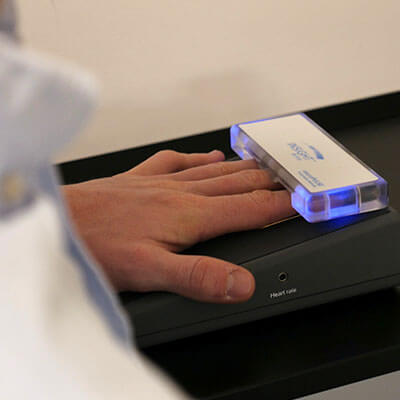 While traditional medicine relies primarily on symptoms and looks for obvious pathology on standard exams like blood work, MRIs, and EEGs, Chiropractors at Advanced Health Chiropractic use an incredible piece of technology called the INSiGHT Scans that accurately assesses the health and function of the Central Nervous System
While traditional medicine relies primarily on symptoms and looks for obvious pathology on standard exams like blood work, MRIs, and EEGs, Chiropractors at Advanced Health Chiropractic use an incredible piece of technology called the INSiGHT Scans that accurately assesses the health and function of the Central Nervous System
When we get into things like technology and neurology, many of us can get overwhelmed and confused quite quickly, but that’s the beauty and practicality of our INSiGHT Scanning Technology – it’s super simple and easy to understand.
This article will help you do just that!
What is the Central Nervous System?
The most critical system that determines whether you, your child (and your entire family) is healthy or not is the Central Nervous System, or just the ‘nervous system’ for short. It’s made up of three divisions, Sensory, Autonomic, and Motor, that work together to coordinate EVERY internal body function with EVERY movement and with EVERY thought, emotion, behavior, and cognitive function. It’s ‘Air Traffic Control’ for the entire human experience!
Dr. Bruce Lipton puts it this way:
“The function of the nervous system is to perceive the environment and coordinate the function of all other cells.”
That means that while you’ve probably invested quite a bit of time, energy, and resources into trying to get cardiovascularly fit and healthy, strong and flexible in the gym, eat healthy and build immune system, you may have overlooked the one common thread that ties them all together – the nervous system.
When you see the word ‘autonomic‘ in this context, it simply means that everything runs on autopilot and happens automatically. The autonomic nervous system controls and coordinates all essential health-building functions in everyone in our community, and we can measure how well (or not) the nervous system is doing its job with our simple, safe, and reliable INSiGHT Scans!
The different approaches
Basically, the examination and assessment process of the 3 different healthcare approaches breaks down like this:
- Traditional Medicine – chases symptoms and looks for obvious pathology, not function
- Movement-Based Therapies (Physiotherapy, massage) - assess muscular or ‘motor tone’ function through various movement assessments, strength tests, etc.
- Chiropractic – assesses and determines the function of the nervous system
How Does It Work?
The nervous system is a two-way street.
One set of nerves is called ‘sensory’ nerves that send information and report to the brain and brainstem precisely what’s going on inside the body (internal environment) and outside the body (external environment).
The other set of nerves is more of what is termed ‘motor control’ nerves that send signals out from the brain and spinal cord and tell the various parts of the body what to do, when to do it, how to do it, etc.
Because neurological communication within the autonomic nervous system has to do this vitally important job for 37.2 million cells in the human body, things need to happen fast and have absolute clear lines of communication. We were designed to operate well past 5G long before it was invented, and we certainly can’t have any member of our family operating at dial-up speeds.
One very important thing to note here, a child’s brain (nervous system) doubles in size during its first year of life and continues growing and developing at that rapid pace for the first 3-7 years of life…
“making sure this system is working at full function is simply the most important exam and assessment any pediatric provider could ever perform for your child.”
What Do the INSiGHT Scans Look For?
The INSiGHT Scans are about finding, tracking, and understanding if subluxation and dysautonomia are present. And if they are, we need to know two things about them:
- How significant or severe (mild, moderate, severe, or intensive)?
- Where within the neurospinal system are things primarily located (tracking, targeting)?

When too much tension and stress is stuck in one specific area of the neurospinal system, it helps us better understand why certain expressions, symptoms and conditions may be present. Additionally, running the INSiGHT Scans as part of a wellness checkup and before any symptoms may be present helps us predict and get ahead of potential trouble later.
What is Subluxation +& Dysautonomia Again?
A Vertebral Subluxation and Dysautonamia cause the nervous system to suffer from three (3) major issues:
- Stuck and Stored stress, tension, spasm, etc.
- Lack of balance, coordination and adaptability
- Disorganization and dysfunction
Some of the signs and symptoms that your nervous system is Subluxated, stressed out, tense, and stuck in sympathetic fight-or-flight mode are things like:
In Children:
- Colic and frequent crying in an infant
- Excessive tantrums and meltdowns in a toddler or preschool-aged child
- Motor and speech delays
- Sensory processing and emotional regulation challenges
- ADHD and anxiety type challenges later on in school-aged children and teens
- Listening and learning challenges
In Adults:
- Inability to handle day to day stress – anxiety, depression, anger, frustration
- Abnormal energy – tiredness, fatigue
- Muscle imbalances, poor posture, aches and pains
- Organ and system challenges – breathing, asthma, digestive conditions
- Stored energy – headaches, back pain, neck pain
While the ‘expression’ or symptom is called something different in each case and in different age groups, the actual root cause behind the challenges is nearly the same – a stressed out, wound up, out-of-balance nervous system.
Now that we understand why the INSiGHT Scans are so important and what they are looking for… let’s dive into each of the three (3) individual scans!
NeuroThermal Scans
This is the first scan our chiropractors at Advanced Health Chiropractic will run, and we can run this scan on everyone from a 1-day old infant to mom and dad, grandparent, in a matter of minutes.
The main thing the NeuroThermal Scans help us find is the regional effects of subluxation and dysautonomia, as well as the depth of the problem. That
Since the core functions of the autonomic nervous system are to coordinate and regulate the function of the digestive system, immune system, hormones, and so forth… This scan helps us really understand what’s going on in our practice members who are struggling with challenges in these areas. Things such as colic, reflux, constipation, chronic ear infections, allergies, adrenal dysfunction, fatigue and sleep disorders.
The scan image below is a NeuroThermal Scan of a child struggling with virtually all those conditions of the neuro-gastric-immune complex and anxiety.
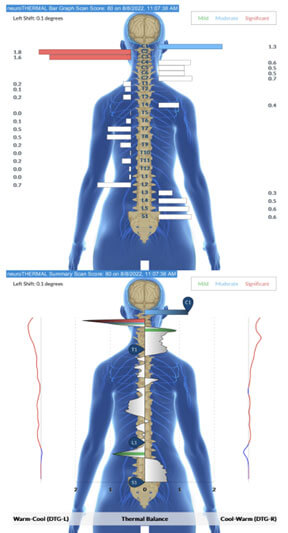
Your chiropractor will explain each scan finding in more detail, but the three (3) things we don’t like to see in these scans are:
- Green, blue, and red bars on the top half NCM graph- indicates that stuck, tension, and sympathetic dominance component of the subluxation.
- Tons of ‘back and forth’ or ‘tug of war’ type tracking and tracking on the bottom summary graph – this indicates dysautonomia and tension throughout the neurospinal system.
- The DTG bars along the sides of the summary graph (bottom half) are inside the black lines and blue – this indicates the subluxation and condition are becoming more chronic.
NeuroSpinal EMG Scans:
This particular scan is vital for us to help people in our community with neurodevelopmental and neurosensory challenges rooted in stuck and stored tension, altered muscle strength and tone, and exhaustion of the neuromotor system.
In children the EMG scan serves as the most important form of testing when conditions like Autism, Asperger’s, Sensory Integration Disorders, ADHD, and Anxiety are being investigated.
In adults, the EMG scan provides essential information for people in our community struggling with regulating emotions, behavior, learning, and memory.
This is because each of these neurodevelopmental and neurosensory challenges is rooted in stuck tension, altered tone, and exhaustion of the neuromotor system.
Neurological and tone challenges are a big deal. If the EMG scan detects patterns of stuck and stored tension and imbalance, the brain is almost certainly stuck in sympathetic (fight or flight) tone and also struggling with an imbalance between its core functions.
There are three (3) common findings with EMG scans, and we’ll briefly describe them here and then show examples of each type below:
- Raging Bull – this is when the nervous system is stuck on the ‘gas pedal’ and entirely sympathetic dominant, leading to challenges with things such as impulsivity, anxiety, difficulty sleeping, and so forth.
- Drunken Bull – this scan finding most often correlates with someone struggling with coordination, focus, reading comprehension, communication, etc.
- Raging Drunken Bull - more often than not in adults who have been subluxated for longer, often they’ll end up with both scan patterns and signs and symptoms of each.
Diving a bit deeper into this particular scan, our INSiGHT EMG Scans also use a 3-step scoring system that allows us to really understand what’s going on with a persons neuromotor system and, thus, overall brain and neurodevelopment.
Here are the 3 scores we see on your EMG Scan and a quick explanation of what they mean, and then we’ve provided some examples of EMG scans as well:
- Total Energy Score – this score tends to go way up in an individual who’s wound up and stuck in sympathetic mode, and therefore a high score here is most often seen with our ‘Raging Bull’ cases struggling with things like anxiety, behavior, energy and sleep issues, and so forth. Adults high in this score tend to have more aches an pains.
- Pattern Score – this is a significant score to the overall neurological tone, and a low score here indicates a person who’s likely struggling with emotional dysregulation, focus and concentration challenges, postural exhaustion and a weak core, and so forth
- Symmetry Score – this score measures the balance between the right and left sides of the neurospinal system, which is crucial to be then sure that there is balance in overall brain function and coordination
Raging Bull (High Total Energy) EMG Scan:
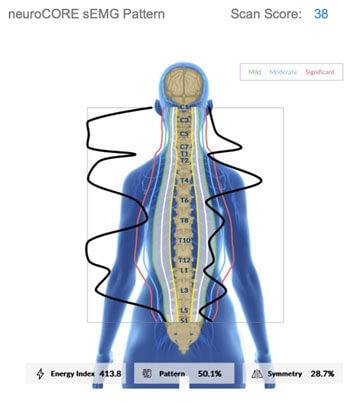
The #1 thing that signifies this scan as a ‘Raging Bull’ scan is the excessively high Total Energy number, shown in the bottom left corner (413.8). The “normal” score should be 100. This means the entire neuromotor system is fully locked into fight-or-flight tone and interfering with neuromotor development and function (standing, walking, etc.), sleep, behavior, emotions, digestion, and more. Interestingly, this child is also a ‘Drunken Bull’ as shown by the other two low scores.
Drunken Bull (Low Pattern + Symmetry) EMG Scan:
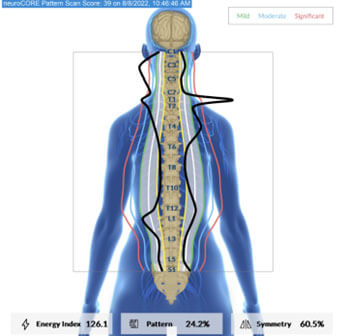
For this individual, her Pattern score being low (24.2) signifies she’s struggling with ‘Drunken Bull’ type neurological challenges – emotional regulation, sensory processing, motor coordination, digestion, and more.
Heart Rate Variability (HRV) Scans:
These scans are beneficial at getting a broader picture of an individuals neurological health, telling us whether their autonomic nervous system is healthy, balanced, and fully charged… or stressed out, imbalanced, and worn out.
The key word here is ‘variability’ because that is indeed the number one marker of good neurological health: the ability to be adaptable and resilient. Adaptability is the key to good health.
Every family member will encounter stress and challenges throughout life; bacteria, viruses, physical injuries, environmental toxins, and emotional challenges, almost daily. So what we know about good health is that it’s not determined by avoiding or trying to hide from these things but by being able to adapt and overcome them.
The HRV Scan is, therefore, a great one to help show an individuals level of adaptability and ability to handle everyday stress and challenges. It is also essential at Advanced Health Chiropractic as we continually assess improvement over time as individuals get neurologically-focused adjustments.
The vast majority of HRV scans in our office look like the sample scan below for kids and adults alike. The white dot to the lower left as it indicates two very common findings that are the result of subluxation and dysautonomia:
- Shifted left – meaning the patient is stuck predominantly in sympathetic fight-or-flight mode and/or has an exhausted parasympathetic nervous system and vagal tone issues
- Shifted low – indicating the patient has lower ‘reserve capacity’ and adaptability, or “low energy”
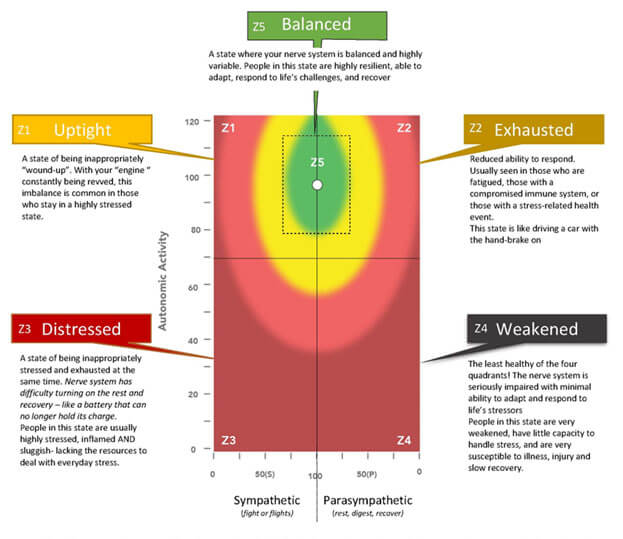
The HRV Scans are the most helpful tool we have in sorting out what’s going on with our community as well as keeping people in a high level of adaptability, health and wellbeing for their entire lives.
Millions of New Zealanders take multiple medications to try and get some sleep, mood regulation, and decrease their pain + tension… and we can get all of that and more with neurologically-focused chiropractic adjustments! Even better, no side effects!
Putting It All Together
While your chiropractor will take you through each scan individually, perhaps the most important aspect of the INSiGHT Scans is being able to put them all together and get a full picture of what’s going on with your nervous system and overall health!
The INSiGHT Scans do exactly what they’re named for – give us insights and an understanding of the most crucial aspect of your health in ways no other health practitioner can.
The nervous system truly is the ‘mom’ of the entire body, keeping everything and everyone on track at all times! And just like quite a few moms, it can get wound up and worn out.
But it truly doesn’t have to be that way! Your chiropractor will put together (or already has) a fully personalized and customized Care Plan just for you. With each adjustment during your Initial or Wellness Care Plan, you’ll see the stuck stress and tension leave your body and the calm, relaxation, and healing capacity kick in!
We can’t wait for you to Experience the Magic that only this kind of chiropractic can bring to the table!
Article adapted from PXDocs by Dr. Tony Ebel
